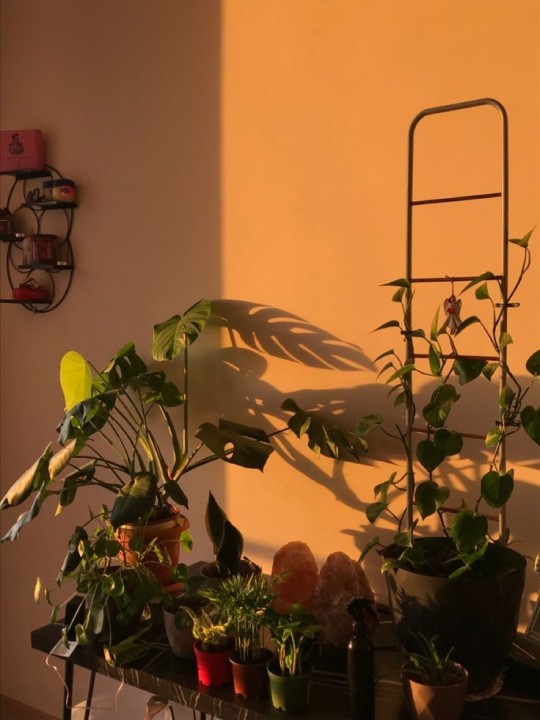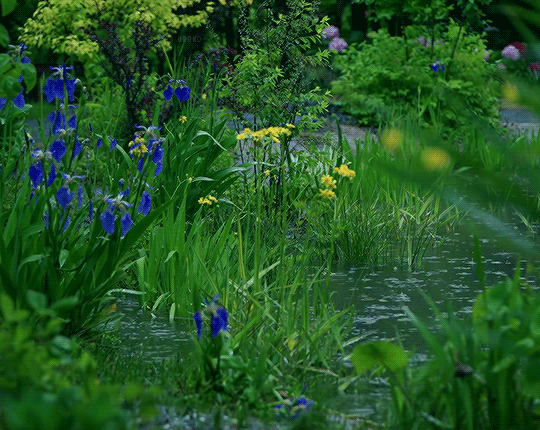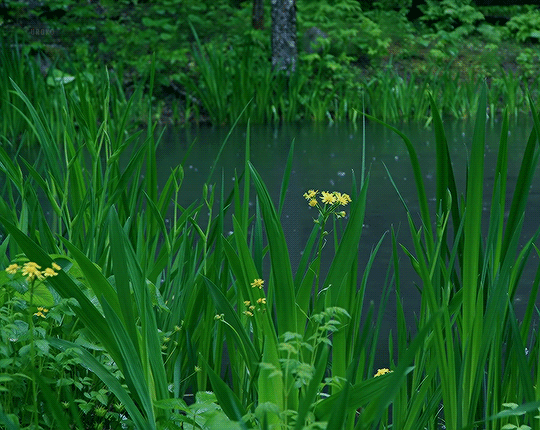#rainy season plant
Explore tagged Tumblr posts
Text

Heleh Lifurloa
If the Clera Fula signifies the start of the rainy season, the Heleh Lifurloa signifies the end. Its root system works tirelessly to help drain the land and stabilize the ground in the wake of the rainy season. In the dry months, however, it's nowhere to be seen. By what process it disappears has yet to be directly observed, but in particularly wet years when the Heleh Lifurloas are far and few in between, they are sometimes seen all year round, vanishing only when the ground around it is sufficiently drained.
It has long, string-like sticky pistils with which to collect wind-blown pollen as Heleh Lifurloas tend not to grow close together. It stores water in its stem, leaves, petals and tubers, which, aside from the petals, all share a glassy appearance. The leaves and tubers swell the more water they collect and shrink as the plant uses it up. The tubers can be shaped to create beautiful, decorative pieces. The leaves and stems are not so easily manipulated, but nevertheless make elegant, decorative pieces if caught before their mysterious disappearance.
The corolla is sometimes plucked to be used as a decorative container, similar to a Jara Flora. The nectar is used to sweeten tea themed around the flower during the Tea Festival. The leaves, stem and tubers can be melted and boiled down to create a slightly sweet syrup as well, but as the initial melted plant is full of water, it usually takes quite a while to boil it down to a syrup, and few parts of the plant are edible without processing. The pistils are trimmed and used to add a sweet, herbal note to tea themed around the plant.
#art#artists on tumblr#drawing#ji planet#ji#floratober#floratober 2024#day 11#rainy season plant#Wing Alayna#Buddy World#Amican Realm#been a while since I've done an oldy goldy#this was from the 2010 tea flowers set#a lot of those are retired now but this one I'd redrawn last year so I had some solid refs to choose from#having the 2010 lore to read from helped me figure out its role as well#all in all a good time#rainy season flora#plains flora#Tea Festival Flora
5 notes
·
View notes
Text

The Chinese lantern plant is one of my favourite flowers... or plants... haha. And for me the bright orange colour gives the perfectautumn vibe. THis is a full watercolour painting :3
#original art#flowers#plants#traditional art#chinese lantern plant#physalis alkekengi#seasons#autumn#watercolor painting#traditional painting#watercolours#rainy day#snail#animals
12 notes
·
View notes
Text









#red panda#animal#paris#eiffel tower#flower#plant#hermione granger#rain#rainy season#drawing#sketch#icons#Pinterest icons#hobby#ramen#color#green#starbucks#random challenge from insta lmao#fyp
8 notes
·
View notes
Video
20240608 Chayagasaka park 2 by Bong Grit Via Flickr: ガクアジサイのアップ。マイクロレンズじゃない50mmだけどエクステンションチューブ入れてマイクロ撮影。 Photo taken at Chayagasaka park, Chikusa ward, Nagoya city, Aichi pref.
#Bokeh#Green#Stamen#Blue#Blue flower#Blue hydrangea#Hydrangea#Flower#Nature#Plant#Rainy season#Chayagasaya park#City park#Chayagasaka#Chikusa#Nagoya#Aichi#Japan#Nikon#Nikon Df#AF-S NIKKOR 50mm f/1.8G (Special Edition)#flickr
4 notes
·
View notes
Text
Rain (Eiji Miyoshi) Enka
youtube
Rain is a special existence for Japanese people. In addition to the four seasons of spring, summer, autumn, and winter, Japan also has a rainy season that lasts for about a month and a half. It's a gloomy season with a lot of humidity and dampness, and it's easy for mold to grow. However, it is also important for planting rice, the basis of Japanese food, and raising seedlings, so it is also a gentle season. This song by Eiji Miyoshi was released 50 years ago when I was a junior high school student. Rain is neither good nor bad here.
雨(三善英史)演歌
雨は、日本人にとって、特別な存在である。春夏秋冬の四季の他に、日本には梅雨があり、ひと月半ほど続く。湿気が多くてジメジメし、カビも生えやすい憂鬱な季節である。だが日本の食の根幹・米の植え付け、育苗が行われる大事な時期でもあり、そう考えると、優しい季節でもある。三善英史のこの曲は、5���年前、私が中学生のころリリースされた曲であり、ここでは雨について、善悪どちらの側面でも歌われていない。
2 notes
·
View notes
Text
@absolut--kurant!




Pyunggang Botanical Garden (평강식물원) // Hello Korea ♡
#good morning! 🌱🌿🌳🍃🌲#so here's storytime (a tiny one)#in the last years of me staying in korea for holidays i had a tiny apartment next to an arboretum#as in i could physically go down the stairs out the building go round the back and the arboretum entrance was right there#i spent many an hour wiling away while i was there and i regret i don't have many pictures of the place#(i was spacing out a lot due to Problems at the time 😥)#but it was always summer when i was there and always humid and part of the rainy season and there was a little lakeside thing#with a traditionally designed gazebo set in the middle (?) of it#and this gifset really reminds me of that place. of the complete peace of standing there and watching the ripples and the water lilies#that's the kind of peace i wish for us always 😌💖#the place is called hanbat arboretum and it seems to have been expanded from last i was there#images on google look lovely))#anyway that's my morning story. i hope you have a good day today my dear 💖💖💖💖💖#life isn't quite like life without plants 🌳
18K notes
·
View notes
Text
I live on a cliff face with a very steep cobblestone street. It’s raining right now which means the street will be too slippery for my bus to go to my house and I’ll have to walk the long way home from my rainy day bus stop.
#rainy season woes#hopefully this means the hydroelectric plants will work#of all the Charlie browns in the world
0 notes
Text
Cannellini Bean Soup
There’s something magical about a warm, comforting bowl of soup that soothes the soul and nourishes the body. If you’re looking for a hearty, nutritious meal that’s easy to make and bursting with flavor, this vegan cannellini bean soup is the perfect choice. Made with canned beans, fresh vegetables, and simple pantry staples, this recipe is both delicious and beginner-friendly. Whether you’re a…
#30-Minute Meals#Comfort Food Season#Compassionate Living#Cooking At Home#Cozy Kitchen#Cozy Nights In#easy vegan recipes#Effortless Vegan#Ethical Eating#Go Vegan#Healthy Choices#Healthy Habits#Kitchen Tips#Mindful Eating#Plant Power#Plant-Based Comfort#plant-based diet#Plant-Based Journey#Quick And Healthy#Rainy Day Eats#Recipe Reel#Self-Care Sunday#Short Form Recipe#Simple Living#Soul Food#Sustainable Living#Vegan Comfort#Vegan Food Hacks#Vegan Food Inspiration#vegan inspiration
1 note
·
View note
Text
How to Care for Your Flowers During the Rainy Season
The rainy season brings both joy and challenges for gardeners. While rain nourishes our plants, it can also lead to problems, especially for flowers. Whether you grow roses, hydrangeas, or indoor blooms, taking care of them during this time is essential. Here’s how to keep your flowers healthy and thriving, both inside and outside your home. Understanding Flower Needs Every flower has unique…
#Banana peel Fertilizer#Blooming Flowers#Eco-Friendly Fertilizer#Flower Care#Flower Gardening#Garden Maintenance#Garden Tips#Gardening Advice#Gardening Hacks#Healthy Plants#Indoor Plants#Outdoor Flowers#Plant Nutrients#Rainy Season Gardening#Sustainable Gardening
0 notes
Text

Mom's rain lily plants used to have lots of flowers when the rainy season arrives. It has stopped blooming when Mom was gone. Last week, I found one flower from the repotted rain lily plant. I pray it will have more flowers soon. It is after all the rainy season now. #flowersmakemesmile
1 note
·
View note
Text
How To Care For Raspberry Plants in The Rainy Season
Status of Raspberry Plants in the Subtropical Urban Eden Lusaka has been receiving occasional rains despite the prevailing drought in the region. These modest amounts of water and summer heat allow low-maintenance plants to flower, grow and fruit. Raspberry plants are thriving and need no extra water unless there is no rainfall for over a week. The challenges that come with the rainy season may…

View On WordPress
0 notes
Text
As relentless rains pounded LA, the city’s “sponge” infrastructure helped gather 8.6 billion gallons of water—enough to sustain over 100,000 households for a year.
Earlier this month, the future fell on Los Angeles. A long band of moisture in the sky, known as an atmospheric river, dumped 9 inches of rain on the city over three days—over half of what the city typically gets in a year. It’s the kind of extreme rainfall that’ll get ever more extreme as the planet warms.
The city’s water managers, though, were ready and waiting. Like other urban areas around the world, in recent years LA has been transforming into a “sponge city,” replacing impermeable surfaces, like concrete, with permeable ones, like dirt and plants. It has also built out “spreading grounds,” where water accumulates and soaks into the earth.
With traditional dams and all that newfangled spongy infrastructure, between February 4 and 7 the metropolis captured 8.6 billion gallons of stormwater, enough to provide water to 106,000 households for a year. For the rainy season in total, LA has accumulated 14.7 billion gallons.
Long reliant on snowmelt and river water piped in from afar, LA is on a quest to produce as much water as it can locally. “There's going to be a lot more rain and a lot less snow, which is going to alter the way we capture snowmelt and the aqueduct water,” says Art Castro, manager of watershed management at the Los Angeles Department of Water and Power. “Dams and spreading grounds are the workhorses of local stormwater capture for either flood protection or water supply.”
Centuries of urban-planning dogma dictates using gutters, sewers, and other infrastructure to funnel rainwater out of a metropolis as quickly as possible to prevent flooding. Given the increasingly catastrophic urban flooding seen around the world, though, that clearly isn’t working anymore, so now planners are finding clever ways to capture stormwater, treating it as an asset instead of a liability. “The problem of urban hydrology is caused by a thousand small cuts,” says Michael Kiparsky, director of the Wheeler Water Institute at UC Berkeley. “No one driveway or roof in and of itself causes massive alteration of the hydrologic cycle. But combine millions of them in one area and it does. Maybe we can solve that problem with a thousand Band-Aids.”
Or in this case, sponges. The trick to making a city more absorbent is to add more gardens and other green spaces that allow water to percolate into underlying aquifers—porous subterranean materials that can hold water—which a city can then draw from in times of need. Engineers are also greening up medians and roadside areas to soak up the water that’d normally rush off streets, into sewers, and eventually out to sea...
To exploit all that free water falling from the sky, the LADWP has carved out big patches of brown in the concrete jungle. Stormwater is piped into these spreading grounds and accumulates in dirt basins. That allows it to slowly soak into the underlying aquifer, which acts as a sort of natural underground tank that can hold 28 billion gallons of water.
During a storm, the city is also gathering water in dams, some of which it diverts into the spreading grounds. “After the storm comes by, and it's a bright sunny day, you’ll still see water being released into a channel and diverted into the spreading grounds,” says Castro. That way, water moves from a reservoir where it’s exposed to sunlight and evaporation, into an aquifer where it’s banked safely underground.
On a smaller scale, LADWP has been experimenting with turning parks into mini spreading grounds, diverting stormwater there to soak into subterranean cisterns or chambers. It’s also deploying green spaces along roadways, which have the additional benefit of mitigating flooding in a neighborhood: The less concrete and the more dirt and plants, the more the built environment can soak up stormwater like the actual environment naturally does.
As an added benefit, deploying more of these green spaces, along with urban gardens, improves the mental health of residents. Plants here also “sweat,” cooling the area and beating back the urban heat island effect—the tendency for concrete to absorb solar energy and slowly release it at night. By reducing summer temperatures, you improve the physical health of residents. “The more trees, the more shade, the less heat island effect,” says Castro. “Sometimes when it’s 90 degrees in the middle of summer, it could get up to 110 underneath a bus stop.”
LA’s far from alone in going spongy. Pittsburgh is also deploying more rain gardens, and where they absolutely must have a hard surface—sidewalks, parking lots, etc.—they’re using special concrete bricks that allow water to seep through. And a growing number of municipalities are scrutinizing properties and charging owners fees if they have excessive impermeable surfaces like pavement, thus incentivizing the switch to permeable surfaces like plots of native plants or urban gardens for producing more food locally.
So the old way of stormwater management isn’t just increasingly dangerous and ineffective as the planet warms and storms get more intense—it stands in the way of a more beautiful, less sweltering, more sustainable urban landscape. LA, of all places, is showing the world there’s a better way.
-via Wired, February 19, 2024
#california#los angeles#water#rainfall#extreme weather#rain#atmospheric science#meteorology#infrastructure#green infrastructure#climate change#climate action#climate resilient#climate emergency#urban#urban landscape#flooding#flood warning#natural disasters#environmental news#climate news#good news#hope#solarpunk#hopepunk#ecopunk#sustainability#urban planning#city planning#urbanism
14K notes
·
View notes
Text
https://ktla.com/news/california/goats-unleashed-by-san-manuel-tribe-as-part-of-fire-prevention-strategy/?fbclid=PAZXh0bgNhZW0CMTEAAaaJJAE-Kl55wk4vm1cYc0zjGRUEv8w6ps0HX0z-rxwwa7YXnTDCsgIU2vs_aem_0djT-2NoD-E87Ic6UeeqGw

Firefighting goats have been deployed by the San Manuel Band of Mission Indians to protect tribal land and neighboring property from potentially devastating brush fires.
The goats are unleashed by the San Manuel Fire Department to eat up dry brush and grass that would normally be ideal fuel for fires — a recent fire was actually partially stopped once it reached an area cleared by the caprine crew earlier this year.
The herd, officials said, is about 400-strong and is made up of generations of goat families.
On Tuesday, the goats were treated to a feast of fruit before being sent on their brush-eating mission.


The goats will spend the next several months trimming and thinning out vegetation on the San Manuel Band of Mission Indians Reservation and nearby properties in San Bernardino.
Tribal officials said the brush that covers the hillsides in and around San Manuel property is thriving and diverse, boosted by the recent history-making rainy season. The plant life is an ideal food source because goats prefer food that’s at their eye level.
The Tribe has used goats as a natural, environmentally friendly fire preventative tool since 2019; the plants get trimmed in a sustainable fashion, which allows them to survive and recover naturally overtime unlike most chemical sprays.
Tribal officials called the practice an extension of the Tribe’s “culture of lands stewardship.”
“Caring for the land is a sacred duty of the Tribe,” said Lynn Valbuena, chairwoman of the San Manuel Band of Mission Indians. “Stewardship is a responsibility given to our people by the Creator. No matter who owns the land.”
San Bernardino County residents shouldn’t be surprised to see the goats in the mountains fulfilling this divine task from now through the end of fire season.
#good news#environmentalism#goats#california#science#environment#nature#animals#indigenous stewardship#land stewardship#usa#sustainability#wildfire prevention#San Manuel Band of Mission Indians#san manuel band#firefighting#articles#news
4K notes
·
View notes
Video
20240608 Chayagasaka park 7 by Bong Grit Via Flickr: 最後は逆光で。 Photo taken at Chayagasaka park, Chikusa ward, Nagoya city, Aichi pref.
#Green#Green leaf#Green leaves#Leaf#Leaves#Pink#Pink flower#Pink hydrangea#Hydrangea#Flower#Nature#Plant#Rainy season#Chayagasaya park#City park#Chayagasaka#Chikusa#Nagoya#Aichi#Japan#Nikon#Nikon Df#AF-S NIKKOR 50mm f/1.8G (Special Edition)#flickr
0 notes
Text
Rice planting (photo collection)

Japan is in the middle of planting "rice seedlings" in the middle of the rainy season in June. May this year be a bountiful harvest of rice, the backbone of Japan!
田植え(写真集)
6月の雨季まっただなか、日本は「イネの苗」を植える真っ最��である。日本を支える根幹である稲、ことしも豊作ならんことを!
(2023.06.16)
Rei Morishita





#Rice planting#Japan#rainy season#bountiful harvest of rice#backbone of Japan#Rei Morishita#photo collection
3 notes
·
View notes
Text
I am super curious about growing sunflowers and pumpkins and a lil mini outdoor pond but also I gotta get an outdoor bucket thing because I’m really bad at dealing with compost smells and well it remind me to make notes about that compacted compost method to make smaller amounts indoors.
#again I hate our patio nothing is ever tall enough to stand up on its own#furniture and plants I mean#I do wonder if we’ll get that large amount of rain in our rainy season#I did water someone’s oyster and lions mane mushrooms once#and she used those large water bucket things
0 notes

